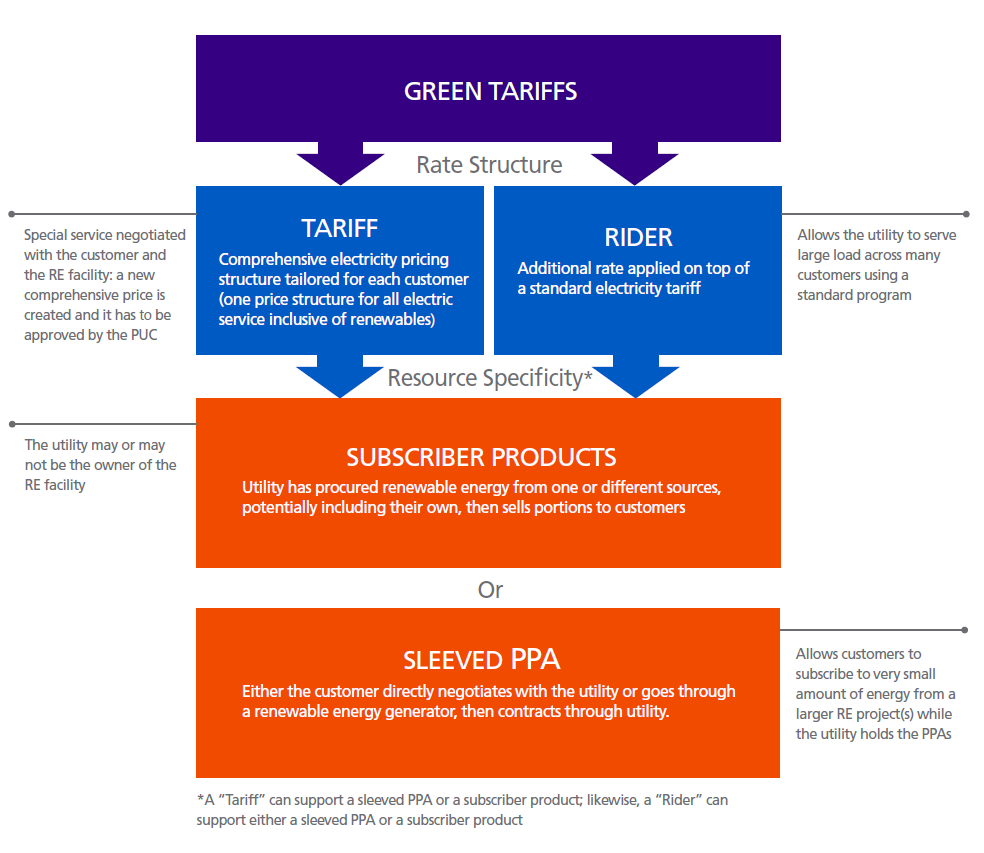Commercial, Industrial, Sourcing Renewables - May 1, 2017 - By Urosh Tomovich
Trends in renewable energy procurement: Green tariffs and aggregating lower volume PPAs
It is no secret that interest among leading corporations to procure renewable energy to meet their energy demands has been growing substantially in recent years. Not only is the energy clean, but as wind and solar prices continue to out-compete wholesale power in an ever-growing subset of electricity markets, it allows those savvy market participants to save money.
Following alongside is the desire for corporate and industrial buyers to procure renewable energy in a manner that allows for a more tangible business connection to the underlying projects – one that creates additionality rather than purchasing unbundled renewable energy credits. This means contracting for the power through long-term, power purchase agreements, or PPAs, tied to a specific project or projects to which the customer can then point to as a generating facility that owes its existence, in large part, to that customer's long term contract.
While the universe of options for meeting renewable energy procurement goals has grown with customer demand – both in terms of available projects, as well as in the transactional structures available – some distinct challenges remain.
Two examples that have been receiving substantive airtime are (1) procuring in regulated/vertically integrated electricity markets, and (2) reaching a critical mass of load/energy demand sufficient to meet project developers' needs with respect to economies of scale and project financing.
Two timely trends that work to address these challenges for C&I buyers by fostering increasingly streamlined, transparent, and accommodating paths to renewable energy procurement are: (1) green tariffs in regulated electricity markets, and (2) aggregation of lower-volume PPAs to meet smaller energy appetites. The former is a more mature trend, by virtue of having established frameworks and numerous executed and late-stage deals in the works; the latter is in a more nascent stage, and so this piece will allocate discussion of each accordingly.
Green tariffs or riders: Partnering with utilities and renewable energy developers in regulated electricity markets
The benefits
Simply put, green tariffs make it easier for corporate buyers to procure renewable energy in regulated electricity markets (e.g., Nevada or North Carolina, where consummating a long-term PPA can be more challenging than in "deregulated/liquid" markets like Texas/ERCOT or California/CAISO). By leveraging active cooperation/partnership with the local, vertically integrated electric utility, green tariffs offer the following benefits for the corporate buyer:
- Energy cost savings afforded by larger, utility-scale renewable energy projects, offered directly through the local utility, at prices that can be as attractive as options available to buyers in the more competitive, unregulated electricity markets;
- Long-term, fixed price structures that decrease exposure to energy price fluctuations (i.e., an effective hedge);
- Ability to point to a specific, often local renewable energy project as the power source for their load within a given geographic footprint.
There are benefits for the partnering utilities as well:
- Accommodating their C&I customers' long-term commitment, particularly in the case of "sleeved PPA" structures, as outlined in the diagram below, whereby the customer signs onto a long-term PPA;
- Increasing geographic and generation source diversity within the state or service territory;
- Potential system-wide benefits and positive externalities such as reduced grid congestion, reduced GHG emissions, and rigorously equitable price/rate setting that contributes to efficient cost recovery through the public utility commission.
The breakdown
Since the first green tariff was proposed by NV Energy in 2013, 10 green tariffs in eight states have been approved or proposed in the U.S. They vary by rate structure, resource specificity, as well as by the extent to which actual deals have been structured or consummated. The four states where deals have been done via green tariffs are Nevada (NV Energy), New Mexico (Public Service Co. of New Mexico), North Carolina (Duke Energy), and Utah (Rocky Mountain Power); the three states with existing/approved green tariff programs that have yet to produce a publically announced deal are Michigan (DTE Energy), Virginia (Dominion Virginia Power), and Washington (Puget Sound Energy); Colorado and Minnesota (Xcel Energy) are both waiting for PUC approval of their respective green tariff filings. The following diagram provides a framework for understanding different green tariff models:

It is important to understand the distinction between the tariff and the rider structure. There is a common misconception among C&I buyers that renewable energy costs more to procure. This is indeed the case for a rider structure, as it is by definition an incremental rate applied to a customer's standard rate; in the case of a true tariff, however, the customer can benefit from a PPA contract on a dedicated renewable energy project, the energy price of which is in most cases lower than the existing wholesale power on that particular grid.
Aggregating lower volume PPAs
The challenges
There seems to be an increasing amount of interest in this concept from corporate buyers and utilities alike. The phenomenon is not entirely novel; there is a large and growing subset of C&I buyers who have had difficulties with procuring renewable energy on the wholesale/"front-of-meter" level; many of them have completed at least one on-site/behind-the-meter project at one of their facilities, and are ready to take their renewable energy procurement to the next level. But they are unable to for one or both of the following reasons:
- Small appetite: Their procurement needs, a function of their load in a given area, fall short of the critical mass typically required to contract for a grid-scale (25 MW) renewable energy project.
- PPA tenor constraints: They are unable or unwilling to sign on for power purchase deals beyond three or five years; most project developers require a minimum of 12 or 15 years for a variety of reasons, most of which come down to project bankability. There are numerous stories over the past several years where project developers, along with their regulated utility intermediaries/partners in some cases, tried earnestly to structure an aggregated "slices" deal, but it ultimately failed given the C&I buyers' internal constraints.
The working solutions
What appears to be changing is the level of motivation for the counterparties to find solutions. As a result, the gap between what customers and developers are willing and able to do appears to be narrowing. The combination of added creativity on behalf of developers to structure products, and greater appetite on behalf of C&I buyers to sign up for longer terms and pay a premium for the aggregation cost/risk is making the prospects for aggregating 5-10 MW slices of projects into 30-50 MW tranches a lot more promising.
If you are reading this as one of the C&I buyers who falls into the category outlined above, we encourage you to stay tuned. There is more to come as the product offering matures on the supply side, and as the market matures on the demand side.
Both green tariffs and aggregation of lower-volume PPAs present exciting new options, which make renewable energy procurement increasingly efficient from a procedural as well as from an economical perspective. These structures should be evaluated with care, and there are plenty of resources available to help C&I buyers make smart energy decisions, including: public reports; experienced renewable energy developers with proven track records of executing deals; and one's own peers across the C&I energy procurement spectrum who may have already worked through the process and seen it from a similar perspective.
 Urosh Tomovich joined EDF Renewable Energy in August 2015 as an associate in their rotational training program, and is currently in the origination group where he supports multiple functions. His prior roles have spanned spearheading company-wide initiatives and supporting risk hedging strategies in the transmission group, as well as the financial modeling and quantitative market analysis of 5.8 GW of projects within the valuation and analytics group. Prior to entering the energy industry, Urosh worked for six years in commercial real estate structured finance, after earning his bachelor's degree in economics at Duke University. He returned to Duke for his MBA and MEM from the Fuqua School of Business and the Nicholas School of Environment.
Urosh Tomovich joined EDF Renewable Energy in August 2015 as an associate in their rotational training program, and is currently in the origination group where he supports multiple functions. His prior roles have spanned spearheading company-wide initiatives and supporting risk hedging strategies in the transmission group, as well as the financial modeling and quantitative market analysis of 5.8 GW of projects within the valuation and analytics group. Prior to entering the energy industry, Urosh worked for six years in commercial real estate structured finance, after earning his bachelor's degree in economics at Duke University. He returned to Duke for his MBA and MEM from the Fuqua School of Business and the Nicholas School of Environment.
Share this valuable information with your colleagues using the buttons below:
« Back to ColumnsStay Up-To-Date












